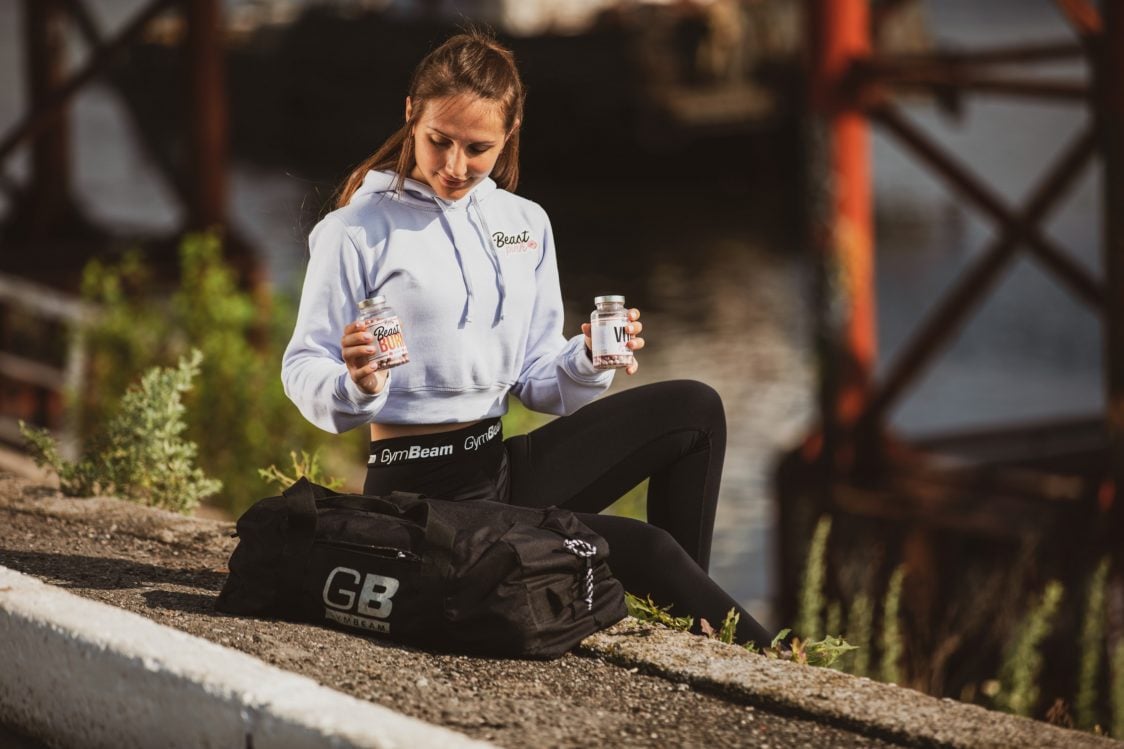Table of Contents
The vast majority of our daily routines shape our lives and have a huge impact on what foods we prefer, whether we live actively or prefer to sit down to watch a new TV series or a movie. We are somehow used to our lifestyle, when we change only a few favorite dishes and we may not even be able to imagine a day without a morning cup of coffee with sweet pastries.
However, every year we want to “do something” with ourselves with iron regularity from January 1, as soon as spring begins and warmer weather comes in handy, before the holidays, from Monday, during the summer or before social events.
There were enough futile attempts that ended in failure. Let’s show you instructions on how to handle it this time and find out how we should on a long-term basis and not just for a month according to the latest diet plans.
Optimal energy intake is the key to losing weight, gaining muscle, or maintaining good fitness.
Vehicles work thanks to fuels, plants bloom and grow thanks to photosynthesis, and we humans obtain energy for life from food and the drinking regime. It is the balanced energy balance, a long-term and average balance between energy intake and energy expenditure, which guarantees that we maintain weight and do not gain or lose body weight. [1]
However, for most people, optimal energy intake is like a god. Everyone somehow suspects that it exists, but no one has ever seen it before. But we will take a look at this optimal energy intake as close as possible.

10 steps to determine the optimal energy intake
Modern scientific knowledge and decades of research show that energy intake with an appropriate ratio of macronutrients determines whether we maintain, gain or lose weight. [2] [3] [4]
Let’s take Carol as an example. She recently started doing sports and would like to strengthen her figure and maybe lose some weight. However, Carol does not know how much energy and macronutrients she should receive. With our instructions, Carol can do it.
1. Write down basic information about yourself
In order for the result of energy intake to be as accurate as possible, we need to know a lot of current information about ourselves.
We need to know: gender, age, height (cm), weight (kg), optionally % of body fat and lifestyle demands from the point of view of job / study and sports activities
Ideally, we also need to know the current intake of energy and nutrients, which we use to maintain our body weight for a period of 1 week.
We know everything we need to know about Carol:
- Carol is 27 years old, 180 cm tall, weighs 80 kilograms and does not know % of her body fat
By an honest weekly entry in the nutritional calculator (MyFitnessPal, Yazio), she found that her average daily energy intake, at which she maintains a stable body weight, is 2,700 kcal.
- Carol works in the office as an administrative worker and spends most of her time sitting at a computer. She spends her free time cooking, reading, watching TV series, with her boyfriend and family. If possible, she goes on trips with her boyfriend over the weekend and spends weekends actively.
- Carol goes to the gym three times a week for an hour for a circular workout and goes swimming for an hour twice a week.
2. Calculate your BMR – basal metabolic rate
The energy hidden under the term basal metabolism is the amount of energy needed to maintain basic bodily functions in complete peace. We can imagine it as relaxing in bed or on the couch without further activity. For most of us, this component accounts for 60-75% of total energy expenditure.
A huge number of more or less accurate calculators to calculate basal metabolism are roaming the waters of the Internet. We can make the calculation easier by using our GymBeam online BMR calculator.
However, for the overall picture and understanding of the issue, we will also do the calculation on paper.
BMR calculation without knowledge of % body fat
Miffin-St. Jeore’s equation is one of the most accurate equations for calculating BMR, so it is used by a number of better quality online calculators. Its wording is as follows.
For men: 10 x weight in kilograms + 6.25 x height in centimeters – 5 x age in years + 5
For women: 10 x weight in kilograms + 6.25 x height in centimeters – 5 x age – 161
Carol calculated: 10 x 80 kg + 6.25 x 180 cm – 5 x 27 years – 161 = 1 629 kcal
BMR calculation with knowledge of % body fat
The Katch-McArdl equation calculates Fat Free Mass (FFM) – fat-free body weight (all body weight after fat deduction), which is more accurate especially for people and athletes with a low % body fat.
For men and women: 21.6 x weight without fat + 370
Carol does not know her % body fat and it is enough to calculate it using Miffin-St. Jeor’s equation.
When calculating BMR, we can encounter a number of equations, including the notorious Harris-Benedict equation. The result of each of them is a slightly different number, which can differ by about 100 kcal. Value calculated using Miffin-St. Jeor’s equation is one of the most accurate and we will follow it in the next calculation. If you are interested in more information about metabolism, read our article What is basal metabolism and how to calculate BMR?

3. Determining the demands of your job and lifestyle
At this point, most mistakes are made, given that we generally tend to overestimate the amount of movement. Determining these coefficients is a very difficult matter for researchers and ourselves when we want to determine our energy needs as accurately as possible.
Lifestyle intensity and activity factor are collectively referred to as the PAL (Physical Activity Level) coefficient. We call this coefficient PAL1. The table below is sort of a stepping stone to determining lifestyle intensity as accurately as possible. If you are not quite sure, direct the estimate to a rather smaller number. The coefficients are based on generally accepted average values, which are similar, for example, to those used by the calculator from the US Department of Health and Human Services.
| lifestyle demands | detailed description | activity factor (coefficient PAL1) |
|---|---|---|
Low | Sedentary work and lifestyle with a minimum of movement during the day | 1,2 – 1,4 |
Light | Little active jobs with a predominance of sedentary work and occasional exercise and routine housework (work in education system, driver of postal and delivery services, salesman) | 1,4 – 1,6 |
Medium | Moderately active jobs with a predominance of work in motion (average demanding manual work, craftsmen, kitchen staff, bicycle delivery) | 1,6-1,7 |
High | Very active jobs with a predominance of manual work throughout the day (demanding work in industry, construction, non-mechanized agriculture) | 1,7-2,4 |
We can begin to argue that we do not live the same way every day. This is especially true on gray days and weekends. What to do in such a case? We add the coefficients PAL1 of individual days during the week and divide by 7. We can be inspired by Carol’s example below.
What lifestyle intensity factor is most accurate for Carol?
We know about Carol that she works in the office as an administrative worker and spends most of her time sitting at a computer. In her free time, she enjoys cooking, reading, watching TV series, or time spent with her boyfriend and family. If possible, she goes on trips with her boyfriend over the weekend and spends her free days actively.
PAL on weekdays: Carol tends to sit, take public transport to and from work, use escalators and rest at home after mentally demanding working days. Her PAL1 will be an estimated 1.3.
PAL over the weekend: Over the weekend, Carol goes on trips to the nature with her boyfriend, does most of the housework, so she is quite active throughout the day. Late Sunday afternoon and evening are devoted to cooking and preparing food in boxes for work. Her PAL1 on weekends is an estimated 1.6.
Average weekday PAL1: Obtained by calculation ((1.3 x 5) + (1.6 x 2)) / 7 = 1.39
4. Determining the complexity of sports activities
Just as we have determined the demands of a lifestyle in terms of energy, we must also determine the energy demands of sports activities that we perform regularly during the week. We must also take into account the intensity of sports activity expressed by heart rate. For example, the more intense (faster) we run, the closer the upper limit of the interval is to the PAL2 coefficient for the running hour.
Indicative values of the coefficient of physical activities (PAL2)
| Type of activity | Indicative average PAL2 PER HOUR OF ACTIVITY |
|---|---|
Strength sports (strength training in the gym, circular training in the gym, crossfit, body weight training, street workout) | 0,2-0,3 |
Team and racquet sports (hockey, football, volleyball, basketball, floorball, futsal, tennis, squash, table tennis) | 0,2-0,45 |
Endurance sports (walking, running, swimming, cycling, rowing) | 0,2-0,5 |
Intensive group activities (aerobics, circuit training, TRX, Body Pump) | 0,3-0,4 |
When we go for a faster walk, the PAL2 coefficient for an hour of activity will be around 0.2. However, if we go jogging intensively at a speed of 10-12 km / h, PAL2 will be somewhere between 0.4-0.5.
Just as we have taken into account the coefficient of lifestyle intensity for an average day, it is also necessary to take into account the intensity of sports activities. Let’s show it again with Carol’s example.
What coefficient of sports activity is most accurate for Carol?
- Carol goes to the gym three times a week for an hour of circular workout and goes swimming for an hour twice a week. Since she is a bit of a newcomer to the gym, the PAL2 coefficient will be at the lower end of the interval. But Carol can swim quite well and does not save energy in an hour in the pool, so PAL2 attacks higher values.
- Carol’s hour-long circural training corresponds to about PAL2 = 0.25 and swimming time to PAL2 = 0.30.
Total volume of sports activities in the week PAL2 = 3 x 0.25 + 2 x 0.3 = 1.35
Average day of the week PAL2: 1.35 / 7 = 0.19

5. Determining the overall intensity of the average day of the week and the average energy intake
Now we simply get the total coefficient of the level of physical activity by simply adding the partial values in the form of PAL1 representing the intensity of work and lifestyle and PAL2 representing sports activities.
What overall average day intensity factor is most accurate for Carol?
PAL = PAL1 + PAL2 = 1.39 + 0.19 = 1.58
Average daily energy intake = BMR x PAL = 1,629 x 1.58 = 2,574 kcal
6. Taking into account the amount of energy needed to process nutrients from food (thermic effect of food)
The thermic effect of food is the energy that the body needs to process nutrients. The amount of this energy corresponds on average to about 10% of the total energy intake.
What is Carol’s resulting optimal average daily energy intake?
Equation for the resulting daily energy intake: BMR x (PAL1 + PAL2) x 1.1 (thermic effect of food)
Resulting daily energy intake: 2,574 x 1.1 = 2,831 kcal
At the beginning, we stated that Carol wrote down everything she ate and drank for a week. Her average daily energy intake was 2,700 kcal. The difference of 131 kcal compared to the calculation is negligible in this case.
But what to do when the calculated energy intake is higher than in the case of a diet record?
Such situations can also occur and usually occur for several reasons. Either we were not consistent in entering food in nutritional calculators, and thus we came up with a distorted number, we made a calculation error and overestimated the coefficient of physical activity, or the inappropriate diets of the past left a mark on us.
If the error occurred in the first two cases, then the situation is fine. However, the problem occurs if, despite all the correctly calculated and recorded values, the maintenance intake is much smaller than the calculated value.
This problem usually occurs in people who have held one or more consecutive diets in the past which have excessively reduced their energy intake. The body has not yet recovered from this “self-harming behavior” and keeps its weight on suspiciously low energy intake. This intake can be tens of % less than the calculated value.
If we have a stable body weight on energy intake that is close to the values of our basal metabolism, we need to think about it and undergo a refeed period. The refeed period can be characterized as a targeted and controlled increase in energy intake to optimal values.
The size of such problematic energy intake can be expressed roughly as follows: BMR x 1.15
For Carol it would be: 1,629 x 1.15 = 1,873 kcal
We see that this is a difference of less than 1,000 kcal compared to the energy intake that Carol calculated. If we consume significantly fewer calories than we should according to the calculation, it is not right and the situation needs to be addressed. This is mainly to make us feel more energetic, to supply the body with enough of all macro and micronutrients and to “start the metabolism at full speed.” In this state, even efforts to lose weight would be almost on the level of the “impossible”. It is simply necessary to gradually increase energy intake and start losing weight only at the point when we will receive enough calories (we can orient ourselves according to the calculation). In this case, Carol should slowly add about 100 kcal per week to her diet, so that her intake reaches more optimal values without a dramatic weight gain and the body recovers from previous periods of dieting. If there was a jump in energy intake by a few hundred calories, we would simply start gaining fat. But we do not want that, so it is necessary to go slow and give it time and care.

7. Optimal adjustment of macronutrients for maintaining body weight and good fitness
Our guide to today’s article in the form of the imaginary Carol should maintain her body weight at an energy intake of 2,831 kcal. Since Carol also does strength training, spends weekends quite actively and she would also like to lose a little weight and strengthen her figure, it is necessary to take into account the higher protein intake.
- 1 g of protein contains 4 kcal (17 kJ)
- 1 g of fat contains 9 kcal (38 kJ)
- 1 g of carbohydrates contains 4 kcal (17 kJ)
How to take protein?
Protein intake falls within the wide recommended range of 0.8-2 grams of protein per kilogram of body weight per day. The lower limit applies to generally inactive individuals who live a sedentary lifestyle, and the upper limit intake is particularly suitable for strength athletes who build muscle mass. If we do sports, our daily protein intake should fall in the range of about 1.4-2 grams per kilogram of body weight. [5] [6] [7]
Although Carol has a sedentary job, she does quite a lot of sports and is also involved in strength training, and at the same time she wants to change her body composition for the better. Therefore, in order to keep it simple, we will choose for her a protein intake of 2 grams per kilogram of body weight. Final protein intake: 2 x 80 = 160 g, 160 x 4 = 640 kcal
- Protein sources: meat, fish, seafood, dairy products and cheese, eggs, legumes (peas, beans, all kinds of lentils, chickpeas, edamame), pseudo-cereals (buckwheat, amaranth, quinoa), tofu, tempeh, nuts, seeds, vegetable meat substitutes, whey protein, vegetable protein, protein bars.
If you are interested in other tips for foods that are rich in protein, read our article 20 foods with which you can easily add protein to your diet
How to take fat?
The normally recommended fat intake should be in the range of 20-30% of total energy intake (TEI). Excessive and insufficient fat intake carries its risks. Fat is an essential nutrient for the optimal functioning of the body, and in addition, it gives food a specific taste. However, it is necessary to be able to choose quality healthy fats and limit the intake of trans fats as much as possible.
- Carol’s fat intake will be a middle ground in the form of 25% of total energy intake. Final fat intake: 2,831 x 0.25 = 707.75 kcal, 707.75 / 9 = 78.5 g
Sources of fat: nuts and seeds, oils, olives, avocados, butter and as a natural component of animal protein.
How to take carbs?
The standard recommended carbohydrate intake falls within a wide range of 40-65% of TEI. It also depends on the preference for fat or carbohydrate intake. It’s up to everyone who chooses the path to the goal. In general, however, it is also true that the more demanding a sport we do, the greater our need for carbohydrates. Carbohydrate intake is simply calculated by subtracting protein and fat from total energy intake. We will meet the preference for quality wholegrain carbohydrates and at least 400 grams of vegetables and 200 grams of fruit per day, as well as the recommended daily fiber intake, which should be at least 30 grams per day.
- Carol’s carbohydrate intake is determined as follows: 2,831 – 707.75 – 640 = 1,483.25 kcal, 1,483.25 / 4 = 371 g
Sources of carbohydrates: whole grains and cereals (oatmeal, flour, rice, pasta, bread and pastries), pseudo-cereals, potatoes and sweet potatoes, legumes, fruits and vegetables.
You might be interested in these products:
Carol’s current routine intake of energy and macronutrients to keep fit:
- 2,831 kcal, 160 g protein (640 kcal), 78.5 g fat (707.75 kcal), 371 g carbohydrates (1,483.25 kcal)

8. How to lose weight? Adjust your energy and nutrient intake for weight loss
In order to lose weight, we need to run into a caloric deficit. We do this simply by deducting a specific % of energy from the maintenance energy intake so that weight loss is safe and fast enough. After all, no one wants to lose muscle mass.
It is most often widely recommended to simply subtract 500 kcal from the current energy intake and that’s it. However, the % expression is better and more concise, when in practice we most often meet with the recommendation of 10-30% of the caloric deficit, when 30% is already such an imaginary limit value of safe weight loss, in which it is necessary to pay attention to sufficient protein intake and focus on strength training in order to maintain as much muscle mass as possible.
- Carol follows the middle ground in the form of a 20% caloric deficit. This means 2,831 x 0.8 = 2,265 kcal for her
We will use the same procedure as in the previous case to calculate the individual nutrients. During weight loss, the importance of protein intake increases, which has a positive effect on maintaining muscle mass, accelerates recovery after training and can help get the appetite under control, which is doubly useful when losing weight. Whey or vegetable protein can help us increase our protein intake. At the same time, Antonio (2016) together with other researchers proved that a protein intake of 2.6-3.3 grams per kilogram of body weight had no negative effect on the liver, kidneys and other biochemical markers during a 4-month period in healthy strength athletes. The larger the caloric deficit and the more demanding the training program, the more pronounced the need for more protein intake and it can reach up to 2.7 g / kg per day. [8] [9] [10] [11] [6] [12]
How did Carol adjust her energy and macronutrient intake for weight loss?
Energy: 2,265 kcal
Protein: 2 x 80 = 160 g protein (640 kcal). Carol has so far been satisfied with 2 g of protein per kilogram of body weight.
Fats: 2,265 x 0.25 = 566.25 kcal, 566.25 / 9 = 63 g fat
Carbohydrates: 2,265 – 640 – 566.25 = 1,058.75 kcal, 1,058.75 / 4 = 265 g carbohydrates
When weight loss stops after a while, it is necessary to update the whole process. This is because we will need less energy. We will simply be smaller versions of ourselves. And the so-called Adaptive thermogenesis, which is manifested by a reduction in thyroid hormones, manipulation of the hormones of hunger and satiety, and also a reduction in energy expenditure through spontaneous and physical activity, is also reflected there. [13]
Fat burners, which work best following a physical activity, can also help us lose weight more effectively. Their often forgotten benefit represents a positive effect on concentration, dedication and concentration during training. Thanks to this, we can burn more calories during training than without using a fat burner.
During weight loss, the scale may show us a larger number than a few days ago, and it is not fat. If you’re wondering how this is possible, read our article Why Scale Shows You a Higher Number and It’s Not Fat.

9. How to gain weight and muscles? Adjust your energy and nutrient intake for muscle gain
To gain body weight and muscles, it is necessary to have a properly compiled training plan that respects progressive overload. Through diet, on the other hand, we need to take in enough energy, protein and micronutrients.
To gain weight, we can bounce off from increasing maintenance intake by about 10%. We achieve this by simply multiplying maintenance income by 1.1. If Carol wanted to gain weight and muscles, it would look like this: 2,831 x 1.1 = 3,114 kcal
Regarding the distribution of nutrients in the diet, we proceed in the same way as in the case of calculating maintenance intake. For the growth of muscle mass, a set protein intake of 2 grams will suffice, thus increasing the adequate intake of fats and carbohydrates.
Once the weight gain has stopped, it is necessary to increase the energy intake again by another 10%, which will start the weight gain processes again. It is completely normal to gain a maximum of 1 kilogram of muscle mass per month. More advanced athletes, due to their natural potential, will then be happy for every extra 100 grams of muscle mass. Care must be taken not to gain unnecessarily large amounts of adipose tissue and to be patient in the process.
If we do not manage to eat enough energy in the form of a solid diet, we can reach for a quality gainer, which is a concentrated source of energy in an easily absorbed liquid form.
Wondering if your muscles need to hurt to grow? In order to learn, read our article Is it true that muscles grow faster after muscle soreness?
10. How to convert the numbers and macronutrients into a diet?
Well, having a calculated energy and macro intake is nice, but unless we see it on a plate, it’s still quite abstract. The easiest thing we can do is to determine the number of meals that suits us and to incorporate popular and healthy food sources of proteins, carbohydrates and fats into the diet.
To illustrate, let’s take Carol and her maintenance values again:
2,831 kcal, 160 g protein (640 kcal), 78.5 g fat (707.75 kcal), 371 g carbohydrates (1,483.25 kcal)
Carol is used to eating 5 times a day in the form of 3 larger meals and 2 snacks. She composed her diet plan with the help of nutritional application as follows.
Carol’s illustrative diet plan
Energy: 2,854 kcal (11,416 kJ), Protein: 162 g (648 kcal or 2,754 kJ), Carbohydrates: 377 g (1,508 kcal or 6,409 kJ), Fats: 72 g (648 kcal or 2,736 kJ), Fiber: 43 g
Breakfast: Oatmeal: oat flakes (60 g), water (280 ml), Just Whey Protein (15 g), FitCheat protein chocolate (10 g), GymBeam peanut butter (10 g), banana (50 g) and defrost berries fruit (100 g)
Snack: Smoothie: apple (150 g), banana (110 g), pear (140 g), oat flakes (10 g), Greek yogurt 0% (70 g), avocado (50 g)
Lunch: chicken breast (100 g) roasted on oil (7 ml) with rice (100 g) and vegetable salad (200 g)
Afternoon snack: Pasta salad: wheat pasta (100 g), Greek yogurt 0% (70 g), tuna (70 g), olive oil (5 ml), cucumber (40 g), red pepper (50 g) , corn (30 g) and spices according to one’s to choice
Dinner: 2 wholemeal kaisers (50 g), spread (30 g), eidam 30% (2 slices), top quality ham (2 slices), hard boiled eggs (0.5 pcs), cucumber (100 g), red pepper (50 g)
Small snack: MoiMüv Protein Bar (60 g)
Carol knows that “liquid calories”, i.e. energy from sweetened drinks, kick in super fast, and therefore the basis of her drinking regime is unsweetened water, quality coffee and tea. When he has juice or sweetened lemonade, she adds it to her daily energy intake and reduces one larger daily meal. However, this only happens very sporadically.
As you can see, it’s really quite a lot of food, but when we imagine in the context of the whole diet that the average person prefers highly industrially processed foods, which have a high energy value in a small volume and do not saturate much, then it’s not so much. In addition, the fruit fiber in the smoothie is so broken from mixing that it cannot be taken into account as the fiber from the whole fruit. Packaging can make it easier to prepare food for the next few days. If you are interested in how to do it, read our article How to effectively prepare meals and pack them?
Yeah, sure, once in a while going to a fast food restaurant can be fine if it helps us maintain a healthy lifestyle in the long run. It must not become an everyday affair. Such a gourmet menu in the fast food chain, which we can eat during one longer session with friends, has an even greater amount of energy than Carol’s all-day ration.
McRoyal Double (754.7 kcal), large fries (434 kcal), Coca Cola – 0.5 l (208 kcal), 2 x Nutella Muffin (2 x 494 kcal), McFlurry Snickers (424 kcal) larger Latte Macchiato (83 kcal) ) = 2 892 kcal
If you are more interested in the possible benefits of occasional visits to fast food and adequate consumption of “unhealthy foods”, read our article Cheat Meal – What it is and how “cheating” works in the diet of athletes

What is the lesson and what helped Carol as much as possible?
Calculating the optimal energy intake for maintaining good fitness, losing weight, or gaining muscle may seem like a difficult task, but once you try it, everything is much more understandable the second time.
The key is to realize that not everything on paper and in equations applies universally to everyone, because each of us is different, has a different “dietary history” that could have had a negative effect on them, and we all live different lifestyles in different environments that have a significant impact on us.
If we maintain a weight on energy intake that is dangerously close to basal metabolic levels, let’s not try to lose weight and rather slowly add on energy intake for a few more weeks and months to get to healthier values, and thus recover from the negative the effect of frequent dieting.
In the first few weeks after calculating her optimal energy and macronutrient intake, Carol improved her overall diet and included healthier foods at the expense of the less healthy and highly industrially processed ones without added nutritional value. Gradually, she stopped drinking alcohol almost completely and exchanged the sweet pastry with cappuccino snack for a protein bar with espresso. Thanks to these changes, she started to feel much better and had more energy for life and training.
- After a few weeks, she set a 20% caloric deficiency with enough protein and fiber in her diet, and once every two weeks, she took a check-up day to weigh and measure her body circumference values to see how she was doing.
- In half a year, when she really became interested in the diet and thought about how she ate, she managed to lose 8 kilograms of fat and gain 3 kilograms of muscle mass and strengthen the body overall.
At the moment, she is satisfied with herself, she feels happy and she is glad that she has set out on the path of self-knowledge and learning, and not on a path of every-week-a-new-diet challenge. Everyone can do it.
Did the article help you clarify the issue of energy intake? Share your observations and gadgets with us in the comments section when calculating the optimal energy intake. If you liked the article, we will be happy if you share it and help others, for example, to lose weight successfully.
Sources: [1] James Hill, Wyatt, H. R., & Peters, J. C. – The Importance of Energy Balance – https://doi.org/10.17925/EE.2013.09.02.111
[2] Krista Casazza, Fontaine, K. R., Astrup, A., Birch, L. L., Brown, A. W., Bohan Brown, M. M., Durant, N., Dutton, G., Foster, E. M., Heymsfield, S. B., McIver, K., Mehta, T., Menachemi, N., Newby, P. K., Pate, R., Rolls, B. J., Sen, B., Smith, D. L., Thomas, D. M., & Allison, D. B. – Myths, presumptions, and facts about obesity. – https://doi.org/10.1056/NEJMsa1208051
[3] Guyenet, S. J., & Schwartz, M. W. – Regulation of Food Intake, Energy Balance, and Body Fat Mass: Implications for the Pathogenesis and Treatment of Obesity. – https://doi.org/10.1210/jc.2011-2525
[4] Hopkins, M., & Blundell, J. E. – Energy balance, body composition, sedentariness and appetite regulation: Pathways to obesity. – https://doi.org/10.1042/CS20160006
[5] Bernaciková, M., Masarykova univerzita, & Fakulta sportovních studií. – Regenerace a výživa ve sportu (1. vyd.)
[6] Ralf Jäger, Kerksick, C. M., Campbell, B. I., Cribb, P. J., Wells, S. D., Skwiat, T. M., Purpura, M., Ziegenfuss, T. N., Ferrando, A. A., Arent, S. M., Smith-Ryan, A. E., Stout, J. R., Arciero, P. J., Ormsbee, M. J., Taylor, L. W., Wilborn, C. D., Kalman, D. S., Kreider, R. B., Willoughby, D. S., … Antonio, J. – International Society of Sports Nutrition Position Stand: Protein and exercise. – https://doi.org/10.1186/s12970-017-0177-8
[7] Andrea Chernus, Heidi Skolnik – Výživa pro maximální sportovní výkon
[8] Jose Antonio, Ellerbroek, A., Silver, T., Vargas, L., & Peacock, C. – The effects of a high protein diet on indices of health and body composition – a crossover trial in resistance-trained men. – https://doi.org/10.1186/s12970-016-0114-2
[9] Antonio, J., Ellerbroek, A., Evans, C., Silver, T., & Peacock, C. A. – High protein consumption in trained women: Bad to the bone? – https://doi.org/10.1186/s12970-018-0210-6
[10] Eric Helms, Zinn, C., Rowlands, D. S., & Brown, S. R. – A systematic review of dietary protein during caloric restriction in resistance trained lean athletes: A case for higher intakes. – https://doi.org/10.1123/ijsnem.2013-0054
[11] Juha Hulmi, Isola, V., Suonpää, M., Järvinen, N. J., Kokkonen, M., Wennerström, A., Nyman, K., Perola, M., Ahtiainen, J. P., & Häkkinen, K. – The Effects of Intensive Weight Reduction on Body Composition and Serum Hormones in Female Fitness Competitors. – – https://doi.org/10.3389/fphys.2016.00689
[12] Thomas Longland, Oikawa, S. Y., Mitchell, C. J., Devries, M. C., & Phillips, S. M. – Higher compared with lower dietary protein during an energy deficit combined with intense exercise promotes greater lean mass gain and fat mass loss: A randomized trial. – https://doi.org/10.3945/ajcn.115.119339
[13] Michael Rosenbaum, & Leibel, R. L. (2010) – Adaptive thermogenesis in humans. – https://doi.org/10.1038/ijo.2010.184







Add a comment